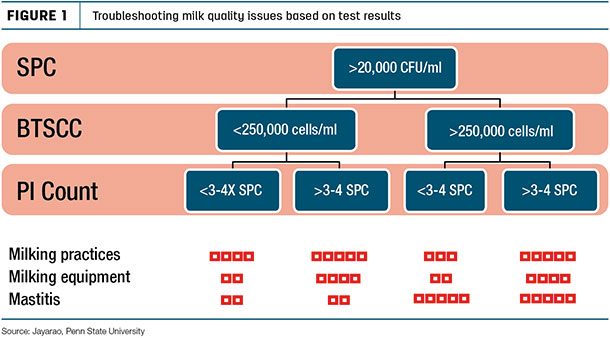Dairy producers are held to high standards. Day after day, farmers are expected to produce consistently high-quality milk. Working with their employees and business partners, they strive to reproduce results seamlessly, fine-tuning and improving management practices when required.
Much attention is given to the art of harvesting milk – and rightly so. In addition to breeding, feeding and housing dairy cows in a conducive and comfortable environment, it is essential to ensure that milking procedures promote consistent milk quality.
To do so effectively, producers follow systematic steps, tools and standard practices which include prep routines, attachment of milking units, monitoring of vacuum levels, application of teat disinfectants, cooling of milk and other important routines according to industry standards.
Perhaps the least glamorous and underappreciated component of this quest for high milk quality is the sanitation aspect. This may be, in part, because sanitation occurs after the milking routine is concluded. It is also an “unseen” chore due to automation through programmable washers.
The washers diligently run their cycles discreetly, in enclosed pipelines far from the producer’s eye. This can lead to an “out of sight, out of mind” mentality that can enable issues to grow and slowly erode milk quality gains.
The importance of cleaning and sanitation cannot be overstated. Bacteria counts reflect one of the most significant parameters impacting how producers are compensated for their milk. Bacteria in milk can affect more than just flavor.
They can impact shelf life, yield and composition of fluid and non-fluid dairy products. Certain bacterial strains may even compromise safety if they are pathogens to humans.
When a concern does arise, pinpointing its cause can take time. However, time is a luxury most producers do not have. If Sherlock Holmes had run a dairy farm, preliminary incubation counts and their mysterious circumstances would have taken much of his time.
While sidekick Watson might start blaming everything from detergents to incidents in the milking and cleaning shifts, the true culprit may take more time to uncover.

More often than not, troubleshooters are not given sufficient or accurate information to achieve a rapid and valid conclusion. They encounter conditions that have been in place for extensive periods of time but do not explain the sudden spike in bacteria or appearance of visual residues in pipelines, claws, receivers and rubber goods.
To help diagnose the cause of the concern, an initial investigation should be made into the following clues:
Cleaners
The first step for any good detective is to carefully examine the history and background of the cleaning operation to determine if and what changes have occurred. It must be determined if cleaners and sanitizers are properly used before moving on to other sources.
All cleaners have an expected shelf life that illustrates the point in which they begin to lose efficacy. A considerably out-of-date product will not perform to expected levels and becomes a liability.
Additionally, producers should verify that the products they use originate from a reputable supplier, backed up by high standards in research and development and quality assurance. A supplier’s reluctance to test a product before bringing it to market should be a big red flag.
Temperature
Always evaluate the conditions in which the cleaners are used. For example, checking the cleaning cycle’s water temperature would help provide clues. Chemicals and milk residue can be sensitive to start and end temperatures.
Too hot a temperature may bake protein to the surfaces of pipelines; too cold may re-deposit milk fat to other surfaces.
Maintenance records
Another common culprit for bacteria growth is lack of preventive maintenance. When economic conditions are depressed, we often see cuts in service and replacement of consumables such as rubber goods and gaskets. The problem is: Overused components can harbor micro-organisms that lead to spikes in bacteria counts.
Installing and maintaining cleaning systems call for functional air injectors, adequate water volume and proper slug formation. All of these items work in synergy to provide a mechanical or scrubbing effect to aid in cleaning performance.
As is the case with the vehicles we drive, milking systems are run daily and are highly dependent on good care.
Visual and chemical inspection
Make sure to evaluate the quality of water utilized in the cleaning routine, ensuring that adequate, potable water is used. Water hardness and presence of specific minerals may dictate different strategies and choice of chemicals used. If residues are visually observed on various surfaces of the milking equipment, they may represent a vast number of potential culprits.
An elusive category of residue are the mundane white deposits.
Although similar in appearance, white residue can originate from different sources such as accumulated powder detergent, presence of barium, silica or simply milk stone. Other visual residues may appear as yellow in color, display a hue of blue rainbow, contain brown or black residues, specks or pitted surfaces.
Determining the nature of the residue is critical to assign the correct usage of chemical and cleaning routines. Adjustments may be needed to maximize the detergent’s potential.
Bacterial strain
The Pasteurized Milk Ordinance dictates guidelines for milk quality expectations. These include methods to determine bacteria counts. These bacteria are primarily classified according to their ability to survive or thrive in varying temperatures. Because different bacteria may overlap in the set classifications, there is an inherent level of complexity in identifying the true source of bacteria.
Common methods used to identify and count bacteria include the standard plate count and plate loop count. Common measuring standards also include coliform counts, which are regulated exclusively in California. Increasingly used are preliminary incubation counts, although no legal standards exist.
These counts are arguably the most elusive for troubleshooters, and many refer to it as chasing ghosts. When measuring preliminary incubation counts, the goal is to look for bacteria that can grow in refrigerated conditions. These include bacteria from the environment, teat skin, cows with mastitis, dirty cows, dirty equipment or cooling tanks.
In conclusion, continually producing high-quality milk to increasingly demanding customers is no easy task. Though it is tempting to focus on other aspects of the operation that are arguably more appealing, we should appreciate the added value dealers and field specialists provide when performing sanitation and troubleshooting services.
We owe much respect to these individuals. Like detectives, they approach challenging situations surrounded by somewhat mysterious clues. Knowing which clues to investigate further, in the end, points to the real culprit. ![]()

-
Jarl Dahlstedt
- Solution Manager for Milk Quality and Animal Health
- DeLaval Inc.
- Email Jarl Dahlstedt






